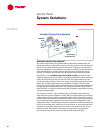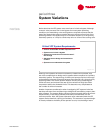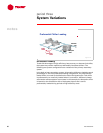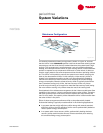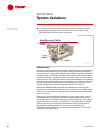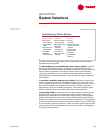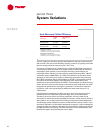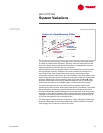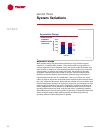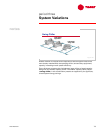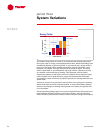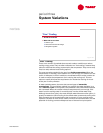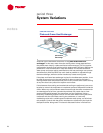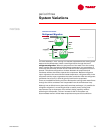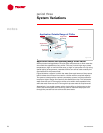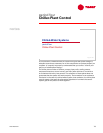
72 TRG-TRC016-EN
notes
period three
System Variations
Asymmetric Design
Many system design engineers seem to default to using chillers of equal
capacity in a multiple-chiller system. There are benefits to using chillers of
varying capacities to more favorably match the system loads. Remember that
when a chiller is started, so is the associated ancillary equipment (pumps and
cooling tower). In general, the smaller the chiller, the smaller the ancillary
equipment. Operating the least number of chillers, and the smallest chiller
possible, to meet the system load minimizes system energy consumption.
Figure 80 examines the use of a “60/40 split,” that is, one chiller (the “lead”
chiller) is sized for 40 percent of the total system capacity and the second chiller
(the “lag” chiller) for 60 percent. Notice that the number of hours of chiller (and
ancillary equipment) operation is reduced by 15 percent, by changing from two
chillers of equal capacity to one chiller at 40 percent capacity and the second
chiller at 60 percent. This is because up to 60 percent load, only one chiller is
operating. Below 40 percent load, only the lead chiller is operating; between
40 and 60 percent load, only the lag chiller is operating. In the same system with
chillers of equal capacity, both chillers and their ancillary equipment are
operating when the load is 50 percent or greater.
Asymmetric Design
annual operating hours
annual operating hours
50% / 50%
50% / 50%
lag
chiller
lag
chiller
60% / 40%
60% / 40%
10,000
10,000
8,000
8,000
6,000
6,000
4,000
4,000
2,000
2,000
0
0
lead
chiller
lead
chiller
▲ Different chiller
capacities
▲ Different chiller
efficiencies
chiller split
chiller split
Figure 80



